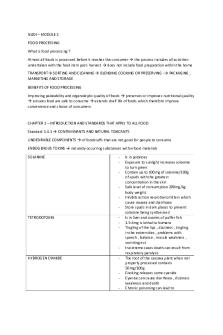PSYC211 Module 2 Lecture 1 Liana Machado PDF

| Title | PSYC211 Module 2 Lecture 1 Liana Machado |
|---|---|
| Author | BSNS 114 otago uni |
| Course | Brain and Cognition |
| Institution | University of Otago |
| Pages | 4 |
| File Size | 193.4 KB |
| File Type | |
| Total Downloads | 72 |
| Total Views | 144 |
Summary
PSYC211 Module two Lecture one Liana Machado...
Description
1.#Neuroanatomy Introduction to the Central Nervous System I.
Overview of the CNS Central Nervous System (CNS)
• •
Brain – cortex and subcortex Spinal cord – housed in the spinal column; sensory information enters the CNS via the dorsal portion of the spinal cord; motor commands exit the CNS via the ventral portion of the spinal cord
Terms of Orientation in the CNS • • •
In reptiles, the same terms of orientation apply throughout the central nervous system. In humans, the terms of orientation in the central nervous system change below the junction with the midbrain (see figure below). Terms of orientation in the human brain stem and spinal cord are easier to understand if you imagine yourself as a quadruped.
Terms of Orientation in the Human CNS •
• • • •
Terms of orientation above the midbrain: anterior = rostral posterior = caudal superior = dorsal inferior = ventral Lateral – toward the side Medial – toward the midline Ipsilateral – on the same side Contralateral – on the opposite side
•
II.
• •
•
Terms for slices of the brain: – Horizontal – Coronal – Sagittal
Anatomical Organization of the Brain
Cerebral Cortex Cerebral cortex is divided into two hemispheres (left and right). Each hemisphere is divided into four lobes: – frontal lobe – parietal lobe – occipital lobe – temporal lobe Insular cortex is hidden inside the lateral sulcus.
Major Gyri and Sulci of the Cerebral Cortex
• • • • •
• •
Cerebral cortex has gyri (ridges) and sulci (fissures). Longitudinal Fissure – separates the two hemispheres Lateral Sulcus – separates the temporal lobe from the frontal and parietal lobes Central Sulcus – separates the frontal and parietal lobes Frontal Lobe – 3 gyri (superior, middle, inferior) run anterior-posterior, meeting the precentral gyrus at the precentral sulcus Temporal Lobe – superior, middle, and inferior gyri Parietal Lobe – postcentral gyrus; intraparietal sulcus (IPS) separates the superior and inferior portions of the parietal lobe
Major Brain Structures/Terms • • • •
Corpus Callosum – main fibre tract connecting the two cerebral hemispheres Cerebellum – large structure attached to the dorsal aspect of the brain stem Subcortical structures (e.g., thalamus and basal ganglia) Thalamus
Thalamus • The thalamus is a subcortical structure • Each hemisphere contains a thalamus • The figure on the right shows a posterior view of the brain stem with the left (coloured green) and right thalami attached. • Which structure has been removed to allow a clear view of the brain stem. •
Basal Ganglia (main structures): 1. Caudate Nucleus 2. Putamen 3. Globus Pallidus
•
Brain Stem Structures 1. Midbrain a) Superior Colliculi b) Inferior Colliculi 2. Pons 3. Medulla
• •
• •
Ventricular System The ventricular system consists of inter-connected cavities filled with cerebrospinal fluid (CSF). Major Divisions: – Lateral Ventricles – IIIrd Ventricle – Cerebral Aqueduct – IVth Ventricle White versus Grey Matter White Matter – axons; myelin is white Grey Matter – cell bodies Brodmann’s Map of the Cerebral Cortex
•
Brodmann’s map is based on differences in the microscopic appearance of the cortex.
Gross Anatomy versus Scans • •
For scans, left and right are reversed. This does not apply to gross anatomy....
Similar Free PDFs

Module 2- Lecture Notes
- 1 Pages

Module 2 - lecture
- 6 Pages

Module 2 - Lecture notes 2
- 4 Pages

UCSP Module 2 - Lecture notes 1-18
- 28 Pages

NSTP-2-Module - Lecture notes 1
- 89 Pages

Module 3 Lecture 1
- 2 Pages

Module 1 lecture
- 25 Pages

Module 1 lecture notes
- 5 Pages

Module-1 - Lecture notes 1
- 10 Pages

Module 1 - Lecture notes 1
- 7 Pages

Module 1 - Lecture notes 1
- 42 Pages
Popular Institutions
- Tinajero National High School - Annex
- Politeknik Caltex Riau
- Yokohama City University
- SGT University
- University of Al-Qadisiyah
- Divine Word College of Vigan
- Techniek College Rotterdam
- Universidade de Santiago
- Universiti Teknologi MARA Cawangan Johor Kampus Pasir Gudang
- Poltekkes Kemenkes Yogyakarta
- Baguio City National High School
- Colegio san marcos
- preparatoria uno
- Centro de Bachillerato Tecnológico Industrial y de Servicios No. 107
- Dalian Maritime University
- Quang Trung Secondary School
- Colegio Tecnológico en Informática
- Corporación Regional de Educación Superior
- Grupo CEDVA
- Dar Al Uloom University
- Centro de Estudios Preuniversitarios de la Universidad Nacional de Ingeniería
- 上智大学
- Aakash International School, Nuna Majara
- San Felipe Neri Catholic School
- Kang Chiao International School - New Taipei City
- Misamis Occidental National High School
- Institución Educativa Escuela Normal Juan Ladrilleros
- Kolehiyo ng Pantukan
- Batanes State College
- Instituto Continental
- Sekolah Menengah Kejuruan Kesehatan Kaltara (Tarakan)
- Colegio de La Inmaculada Concepcion - Cebu




